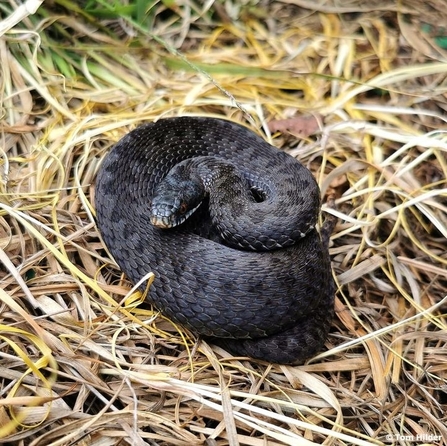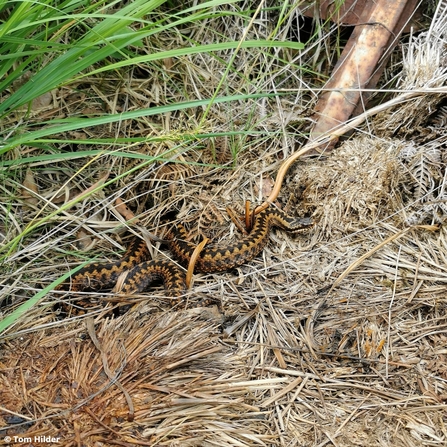One of only three native snake species, the common adder (Vipera berus) calls the heathlands and woodlands of Britain home. Although normally associated with a warmer climate, as temperatures dip these serpentine residents don’t simply succumb to the chill. Instead, they undergo a series of fascinating changes to ensure their resilience in the face of the impending winter.
What happens to snakes in Winter?

Black adder © Tom Hilder
One of their remarkable strategies involves a gradual shift in behaviour. In the autumn months adders are often found basking in the dappled sunlight, here they begin to decrease their activity levels. The diminishing daylight triggers a slowdown in their metabolism, preparing them for the reduced availability of prey and the colder temperatures that lie ahead.
Seeking out hibernation sites becomes a critical task for adders and other British reptiles during this time. From October they retreat to secluded spots, such as burrows or beneath dense vegetation, where they can escape the harsh winter conditions until reemerging in March. These chosen locations offer a stable environment that protects them from extreme temperature fluctuations and predators.
In their chosen winter havens, adders benefit from the insulating properties of the earth. This subterranean refuge shields them from the biting cold, creating a microclimate conducive to their winter dormancy. As the world above ground freezes, these reptiles remain tucked away, their slowed heartbeat and reduced bodily functions enables them to endure the winter with minimal energy expenditure.
Adders and other reptiles also engage in a fascinating process known as brumation, which is essentially a reptilian version of hibernation. Brumation involves a state of dormancy where the metabolic rate drops significantly, allowing the animals to conserve energy.

Female adder at Hook common and Bartley Heath Nature Reserve © Tom Hilder
Yet, the preparations of British reptiles extend beyond individual survival. Their behaviour contributes to the delicate balance of the ecosystem. By regulating populations of prey species and serving as prey themselves, adders and their reptilian counterparts play a vital role in maintaining the biodiversity of their habitats.
Head out to woodland glades or heathlands, such as those found at Hook Common and Bartley Heath Nature Reserve, next spring to spot these fascinating creatures as they reappear from their winter hibernation.
An abundance of native species, including adders, flourish at this Hampshire & Isle of Wight Wildlife Trust nature reserve thanks to its careful restoration.

